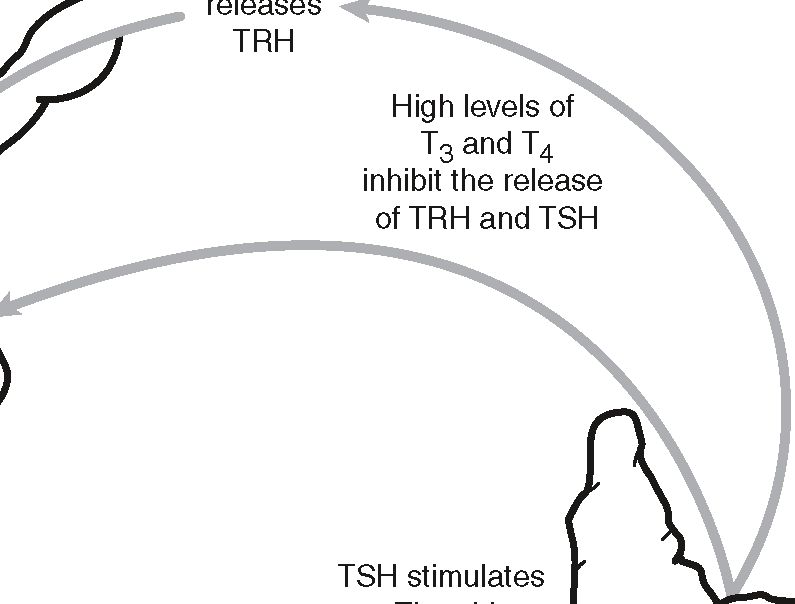Anatomy and Physiology: Pituitary: The First Lieutenant
Pituitary: The First Lieutenant
Now that you've met the “master gland's master gland,” you'll meet the first lieutenant: the pituitary gland (hypophysis). As explained in the previous section, there are two parts to the pituitary: the anterior section (adenohypophysis), and the posterior section (neurohypophysis).
The anterior pituitary has many more hormones than the posterior, and they differ in that they are actually made there, making them true pituitary hormones, rather than axonal carpetbaggers (see Figure 18.3). The cells of the hypophysis are divided according to the cells that make them. If you use a little logic, I bet you can figure out which hormones are made by which cells. (Just use the little tricks to vocabulary that I have been teaching you all along!)
Somatotrophs (soma = body) make the hormone that affects every cell in the body: human growth hormone (hGH). Lactotrophs (this one's easy) affect lactation (the making of breast milk), and so they make prolactin (PRL). Corticotrophs affect a cortex, in this case producing adrenocorticotropic hormone (ACTH), which targets the adrenal cortex, and melanocyte-stimulating hormone (MSH); melanocytes are found in the equivalent of the cortex of the skin—the epidermis. Thyrotrophs release thyroid-stimulating hormone (TSH), of course! The last ones, my favorites, are called gonadotrophs, which release follicle-stimulating hormone. (FSH) Thyrotrophs release and luteinizing hormone (LH), both of which target the gonads (ovaries and testes). The following table lists the effects of the multiple pituitary hormones.
Medical Records
Human growth hormone (hGH) is released throughout a person's life, with little bursts just prior to dawn (causing a rise in the fasting blood glucose of diabetics called dawn phenomenon). If the amount of hGH is too low in one's youth, it leads to pituitary dwarfism, and if it's too high in youth, it leads to gigantism. Once we reach adulthood, the epiphyseal plates (where bone growth occurs, see The Bones) have ossified everywhere except the hands, feet, and face. In adulthood, too much hGH leads to growth in those three areas, a condition called acromegaly.
| The Effects of Pituitary Hormones | ||
|---|---|---|
| Hormone | Target | Effect |
| ACTH | Adrenal cortex | Glucocorticoids secreted |
| ADH | Kidneys | H2O reabsorbed, blood volume up |
| FSH | Ovaries (females) | Follicle dev., estrogen is made |
| Testes (males) | Sperm development and maturation | |
| hGH | All tissues | Growth, anabolism, and catabolism |
| LH | Ovaries (females) | Ovulation and corpus luteum is made |
| Testes (males) | Production of testosterone | |
| MSH | Melanocytes | Increased melanin production |
| OT | Uterus, mammary | Labor contractions and milk |
| glands (females) | ejection | |
| Vas deferens and prostate (males) | Contraction of vas deferens and prostate gland | |
| PRL | Mammary glands | Lactation (milk production) |
| TSH | Thyroid glands | Thyroid hormones produced |

Figure 18.3An overview of some of the basic pituitary hormones, and their target organs. (Note: PRL appears here as PR.) (LifeART©1989-2001, Lippincott Williams & Wilkins)
Pining for the Pineal
The Big Picture
Many years of nature videos as a kid always left me with the question: Why do so many animals mate in springtime? It always made sense, because there was more food for the young then, but how was the body kept infertile in the winter? Yeah, I was a weird kid for asking such questions, but what can you do? The answer is elegant in its simplicity: 1) Winter is darker, 2) darker means more melatonin, 3) melatonin inhibits GnRH, 4) less GnRH makes you infertile. It's so simple it's cool!
The pineal gland (epiphysis cerebri) is posterior to the pituitary (but higher up, as the name epiphysis implies), behind the brain stem, kind of hidden back where the two hemispheres of the cerebellum meet. This little wonder, so deep in our head, is not too far from where our visual pathways make it to our occipital lobe. Given this gland's function, it makes perfect sense!
The pineal gland controls our circadian rhythm (day-and-night cycles). As you can imagine, this depends on the amount of light that reaches our eyes. We don't think about it, because night and day are, well, out of our control. If you ever live near either pole, however, you will experience prolonged days and nights. (In the extreme, you will have one six-month day, and one six-month night a year!) As such, people respond by altering the amount of artificial light to compensate.
The hormone responsible for this is called melatonin, which is produced by pinealocytes, but only in the dark. This helps explain seasonal affective disorder (with the all-too-clever acronym SAD), in which a lack of sunlight in winter leads to the overproduction of melatonin, and ultimately to depression. The treatment, literally, is more light, quite simply to reduce the amount of melatonin. Although little understood, melatonin slows the release of GnRH and is thought to play a role in the onset of puberty.

Excerpted from The Complete Idiot's Guide to Anatomy and Physiology © 2004 by Michael J. Vieira Lazaroff. All rights reserved including the right of reproduction in whole or in part in any form. Used by arrangement with Alpha Books, a member of Penguin Group (USA) Inc.
To order this book direct from the publisher, visit the Penguin USA website or call 1-800-253-6476. You can also purchase this book at Amazon.com and Barnes & Noble.







